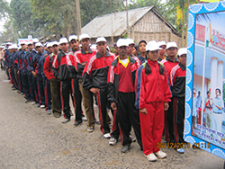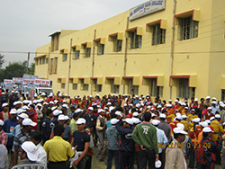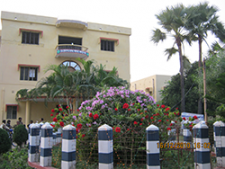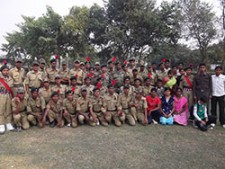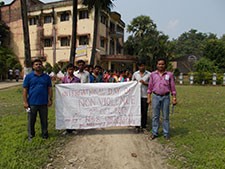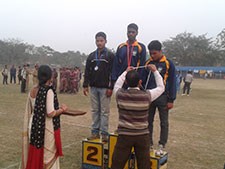Mathematics
- Introduction
- Curriculum
- Teaching & Learning
- Learning Resources
- E-Learning initiatives
- Seminar, Conferences, Webinar and Workshops
- Notices & Events
- Contact Information
History of the Department
The Department was established at the moment our college start his journey in 2000. At that time the subject used to be taught in B.Sc (General Course only). The department was started with one full time faculty Dr. Swapna Mukherjee , former principal of this college. The Honours curriculum was introduced from the session 2007-08 and our mother University (University of Gour Banga ) has introduced the Choice Based Credit System(CBCS) from the session 2019-20.
Currently the department has two full time faculty and two state approved college teacher. This department has served the need of the local students who want to study mathematics in higher education. Several bright students have passed out from this department.
Vision and Mission
- To impart mathematical thinking and Reasoning ability to the students.
- To create interest to opt for mathematics as a major subject in higher education.
- To raise the standard of our students to global levels and make them employable.
- To provide a platform to the students to exhibits their talents and creativity.
- To provide rock solid background for higher level mathematics.
- To encourage self evaluation, personality development and guide the students to strive towards perfection and competence
- Department of mathematics provides excellent teaching and learning environment with its focus on continuing education.
Honours Program
Honours Program
Objectives of Honours Program
- The graduates will become successful professionals by demonstrating logical and analytical thinking abilities.
- The graduates will work and communicate effectively in inter-disciplinary environment, either independently or in a team, and demonstrate leadership qualities.
- The graduates will engage in life-long learning and professional development through self-study, continuing education or professional and doctoral level studies.
- Function on multidisciplinary teams by working cooperatively, creatively and responsibly as a member of a team.
- Provide a systematic understanding of the concepts and theories of mathematics and there application in the real world – to an advanced level, and enhance career prospects in a huge array of fields.
Syllabus for the Honours Program
*For 1+1+1 system students – CLICK HERE
* For CBCS system students- CLICK HERE
Course Outcome for Mathematics Honours Students (1+1+1 Programme)
Part-I
Paper-I Algebra (100 Marks)
Course specific outcomes:
- Understand the importance of roots of real and complex polynomials and learn various methods of obtaining roots.
- Familiarize with relations, equivalence relations and partitions.
- Application of De Moivre’s theorem to solve the numerical problems easily.
- Recognize consistent and inconsistent systems of linear equations by the row echelon form of the augmented matrix, using rank.
- Find eigen values and corresponding eigen vectors for a square matrix.
- Introduction to vector space and subspace.
- Use computational techniques and algebraic skills essential for the study of systems of Linear equations, matrix algebra, vector spaces, eigenvalues and eigenvectors, Orthogonality and Diagonalization. (Computational and Algebraic Skills).
- Relate matrices and linear transformations; compute eigen values and eigen vectors of linear transformations.
- Learn properties of inner product spaces and determine orthogonality in inner product spaces.
- Realize importance of adjoint of a linear transformation and its canonical form.
- Recognize the mathematical objects called groups.
- Link the fundamental concepts of groups and symmetries of geometrical objects.
- Explain the significance of the notions of cosets, normal subgroups, and factor groups.
- Analyze consequences of Lagrange’s theorem.
- Learn about structure preserving maps between groups and their consequences.
- Understand the basic concepts of group actions and their applications.
- Recognize and use the Sylow theorems to characterize certain finite groups.
- Know the fundamental concepts in ring theory such as the concepts of ideals, quotient rings, integral domains, and fields.
- Learn in detail about polynomial rings, fundamental properties of finite field extensions, and classification of finite fields.
Paper-II Calculus (100 Marks)
- Assimilate the notions of limit of a sequence and convergence of a series of real numbers.
- Understand many properties of the real line ℝ and learn to define sequence in terms of functions from ℝ to a subset of ℝ
- Recognize bounded, convergent, divergent, Cauchy and monotonic sequences and to calculate their limit superior, limit inferior, and the limit of a bounded sequence.
- Apply the ratio, root, alternating series and limit comparison tests for convergence and absolute convergence of an infinite series of real numbers.
- Apply derivative tests in optimization problems appearing in social sciences, physical sciences, life sciences and a host of other disciplines.
- Calculate the limit and examine the continuity of a function at a point.
- Understand the consequences of various mean value theorems for differentiable functions.
- Sketch curves in Cartesian and polar coordinate systems.
- Learn some of the properties of Riemann integrable functions, and the applications of the fundamental theorems of integration.
- Geometrical representation and problem solving on MVT and Rolls theorem.
- Finding extreme values of function.
Part-I
Paper-III Geometry & Dynamics (100 Marks)
- Introduction to analytical geometry of 2 dimensional.
- To learn analytical geometry 3 dimensions which include study of conics, planes, lines, sphere, cone and cylinder.
- Finding equation in various form of line, circle, ellipse, sphere, cones etc.
- Familiarize with subject matter, which has been the single centre, to which were drawn mathematicians, physicists, astronomers, and engineers together.
- Understand necessary conditions for the equilibrium of particles acted upon by various forces and learn the principle of virtual work for a system of coplanar forces acting on a rigid body.
- Determine the centre of gravity of some materialistic systems and discuss the equilibrium of a uniform cable hanging freely under its own weight.
- Deal with the kinematics and kinetics of the rectilinear and planar motions of a particle including the constrained oscillatory motions of particles.
- Learn that a particle moving under a central force describes a plane curve and know the Kepler’s laws of the planetary motions, which were deduced by him long before the mathematical theory given by Newton.
Paper-IV Vector analysis, Differential Equation & LPP(100 Marks)
- Define vector equation for lines and planes.
- Analyze vector functions to find limits, derivatives, tangent lines, integrals, arc length, curvature, torsion
- Compute limits and derivatives of functions of two and three variables.
- Differentiate Vector fields.
- Calculate work, circulation, flux and verify path independent.
- Evaluate line integral surface area and surface integrals.
- Analyze and solve linear programming models of real life situations.
- Provide graphical solutions of linear programming problems with two variables, and illustrate the concept of convex set and extreme points.
- Understand the theory of the simplex method.
- Know about the relationships between the primal and dual problems, and to understand sensitivity analysis.
- Learn about the applications to transportation, assignment and two-person zero-sum game problems.
- Understand the genesis of ordinary as well as partial differential equations.
- Learn various techniques of getting exact solutions of certain solvable first order differential equations and linear differential equations of second order.
- Know Picard’s method of obtaining successive approximations of solutions of first order ordinary differential equations, passing through a given point in the plane.
- Learn about solution of first order linear partial differential equations using Lagrange’s method.
- Know how to solve second order linear partial differential equations with constant coefficients.
- Formulate mathematical models in the form of ordinary and partial differential equations to problems arising in physical, chemical and biological disciplines.
Part-III
Paper-V Real Analysis , Metric Spaces & Comples Analysis (100 Marks)
- Learn about Riemann integrability of bounded functions and algebra of R-integrable functions.
- Determine various applications of the fundamental theorem of integral calculus.
- Relate concepts of uniform continuity, differentiation, integration and uniform convergence.
- Learn basic facts about the cardinality of a set.
- Understand several standard concepts of metric spaces and their properties like openness, closedness, completeness, Bolzano-Weierstrass property, compactness, and connectedness.
- Identify the continuity of a function defined on metric spaces
- Visualize complex numbers as points of ℝ𝟐, stereographic projection of complex plane on the Riemann sphere and various geometric properties of linear fractional transformations.
- Understand the significance of differentiability and analyticity of complex functions Riemann equations.-leading to the Cauchy Goursat theorem and Cauchy integral formula in evaluation.
- Understand the convergence, term by term integration and differentiation of a power series.
- Learn Taylor and Laurent series expansions of analytic functions; classify the nature of singularities, poles and residues and application of Cauchy Residue theorem
Paper-VI Probability, Statistics, Numerical Analysis and Computer Programming(100 Marks)
i)Understand the basic concepts of probability. ii) Appreciate the importance of probability distribution of random variables and to know the notion of central tendency. iii) Establish the joint distribution of two random variables in terms their correlation and regression. iv) Understand central limit theorem which shows that the empirical frequencies of so many natural populations exhibit normal distribution. v) Obtain numerical solutions of algebraic and transcendental equations. vi) Find numerical solutions of system of linear equations and to check the accuracy of the solutions. vii) Learn about various interpolating and extrapolating methods to find numerical solutions. viii) Solve initial and boundary value problems in differential equations using numerical methods. ix) Apply various numerical methods in real life problems. x) Understand and apply the C programming concepts for solving mathematical problems using bisection method, Simpsons 1/3 rule, trapezoidal method, Runge Kutta method.
Paper-VII Vector analysis, analytical Statics, Rigid dynamics & Hydrostatics (100 Marks)
i)Serret formulae and theirLearn various properties of curves including Frenet applications. ii) Know the Interpretation of the curvature tensor, Geodesic curvature, Gauss and Weingarten formulae. iii) Evaluate line integral surface area and surface integrals. iv)Understand the reduction of force system in three dimensions to a resultant force acting at a base point and a resultant couple. v) Learn about a null point, a null line, and a nul plane with respect to a system of forces acting on a rigid body together with the idea of central axis. vi) Know the inertia constants for a rigid body and the equation of momental ellipsoid together with the idea of principal axes and principal moments of inertia to derive Euler’s dynamical equations. vii) Study the kinematics and kinetics of fluid motions to understand the equation of continuity in Cartesian, cylindrical polar and spherical polar coordinates which are used to derive Euler’s equations and Bernoulli’s equation. viii) Deal with two-dimensional fluid motion using the complex potential and also to understand the concepts of sources, sinks, doublets and the image systems of these with regard to a line and a circle. ix) describe the physical properties of a fluid.
x) calculate the hydrostatic pressure and force on plane and curved surfaces.
xi) describe the principles of motion for fluids.
xii) formulate the motion of fluid element.
Paper-VIIIA Abstract & Linear Algebra, Differential Equation, Tensor Calculus (60 Marks)
i) Explain the significance of the notions of cosets, normal subgroups, and factor groups. ii) Analyze consequences of Lagrange’s theorem. iii) Learn about structure preserving maps between groups, homomorphism, isomorphism and their consequences. iv) Relate matrices and linear transformations, compute eigen values and eigen vectors of linear transformations. v) Realise importance of adjoint of a linear transformation and its canonical form. vi) Concept of laplace transformation and its inverse.
vii) Apply Laplace transform and its inverse to solve initial value and other related problems.
viii) Explain the basic concepts of tensors.
ix) Understand role of tensors in differential geometry. x) Learn various properties of curves including Frenet Serret formulae and their applications. xi) Know the Interpretation of the curvature tensor, Geodesic curvature, Gauss and Weingarten formulae. xii)Apply a range of techniques to solve first & second order partial differential equations. xii) Model physical phenomena using partial differential equations such as the heat and wave equations.
Course Outcome for Mathematics Honours Students (CBCS Programme)
SEMESTER-I
DC-01 Calculus and Geometry (50 Marks)
i)Assimilate the notions of limit of a sequence and convergence of a series of real numbers. ii) Understand many properties of the real line ℝ and learn to define sequence in terms of functions from ℝ to a subset of ℝ iii) Recognize bounded, convergent, divergent, Cauchy and monotonic sequences and to calculate their limit superior, limit inferior, and the limit of a bounded sequence. iv) Apply the ratio, root, alternating series and limit comparison tests for convergence and absolute convergence of an infinite series of real numbers. v) Apply derivative tests in optimization problems appearing in social sciences, physical sciences, life sciences and a host of other disciplines. vi) Calculate the limit and examine the continuity of a function at a point. vii) Understand the consequences of various mean value theorems for differentiable functions. viii) Sketch curves in Cartesian and polar coordinate systems. ix)Sketch curves in a plane using its mathematical properties in the different coordinate systems of reference. x) Apply derivatives in Optimization, Social sciences, Physics and Life sciences etc. xi) Compute area of surfaces of revolution and the volume of solids by integrating over cross-sectional areas. xii) Introduction to analytical geometry of 2 dimensional. xiii) To learn analytical geometry 3 dimensions which include study of conics, planes, lines, sphere, cone and cylinder. xiv)Finding equation in various form of line, circle, ellipse, sphere, cones etc.
DC-02 Algebra (50 Marks)
i) Understand the importance of roots of real and complex polynomials and learn various methods of obtaining roots. ii) Familiarize with relations, equivalence relations and partitions. iii) Application of De Moivre’s theorem to solve the numerical problems easily. iv) Recognize consistent and inconsistent systems of linear equations by the row echelon form of the augmented matrix, using rank. v) Find eigen values and corresponding eigen vectors for a square matrix. vi) Solutions of reciprocal and binomial equations.
vii) Algebraic solutions of the cubic (Cardon’s) and biquadratic (Ferrari’s). Properties of the derived functions.
viii) Know about equivalence relations and partitions, Functions, Composition of functions, Invertible functions, One to one correspondence and cardinality of a set. ix) solution sets of linear systems, applications of linear systems, linear indepen-dence. x) Real Quadratic Form involving not more than three variables. xi) Characteristic equation of square matrix of order not more than three determination of Eigen Values and Eigen Vectors. Cayley-Hamilton Theorem.
SEMESTER-II
DC-03 Real Analysis (50 Marks)
i) Development of real numbers. The algebraic properties of ℝ, rational and irrational numbers, the order properties of ℝ.
ii) Absolute value and the real line, bounded and unbounded sets in ℝ, supremum and infimum, neighbourhood of a point.
iii) Understand sequences, the limit of a sequence and the notion of convergence, bounded sequences, limit theorems, squeeze theorem, monotone sequences, monotone convergence theorem.
iv) Learn subsequences, monotone subsequence theorem and the Bolzano-Weierstrass theorem, the divergence criterion, limit superior and limit inferior of a sequence, Cauchy sequences, Cauchy’s convergence criterion.
v) Learn sequential criterion for limits, divergence criteria. Limit theorems, infinite limits and limits at infinity. Continuous functions, sequential criterion for continuity and discontinuity.
Vi) Familiarize algebra of continuous functions. Continuous functions on an interval, intermediate value theorem, location of roots theorem, preservation of intervals theorem.
vii) Uniform continuity, non-uniform continuity criteria, uniform continuity theorems.
viii)Applications of mean value theorem to inequalities, relative extremum and approximation of polynomials.
ix)The intermediate value property of derivatives, Darboux’s theorem. L’Hospital’s rule. Taylor’s theorem and its application. Ex pansion of functions.
DC-04 Abstract Algebra (50 Marks)
i) Definition and examples of groups, elementary properties of groups.
ii) Understand subgroups and examples of subgroups, centralizer, normalizer, center of a group.
iii) Properties of cyclic groups. iv) Classification of subgroups of cyclic groups. Permutation group, cycle notation for permutations.
v) properties of permutations, even and odd permutations, alternating group. Cosets, properties of cosets.
vi) Lagrange’s theorem and consequences including Fermat’s Little theorem. Normal subgroup and quotient group.
vii) Learn group homomorphisms, properties of homomorphisms, properties of isomorphisms. First, Second and Third isomorphism theorems.
viii) Definition and examples of rings, elementary properties of rings, subrings, integral domains and fields, characteristic of a ring. Ring homomorphisms, properties of ring homomorphisms.
ix) Learn first Isomorphism theorem. Isomorphism theorems II and III(statement only),field of quotients. Elementary properties of field. Introduction to polynomial ring.
x) Learn about Ideal, ideal generated by a subset of a ring, factor rings, operations on ideals, prime and maxi- mal ideals.
SEMESTER-III
DC-05 Real AnalysisII (50 Marks)
i)Properties of monotone functions. Functions of bounded variation, total variation, continuous functions of bounded variation. ii) Understand Curves and paths, rectifiable paths and arc length. iii) Learn Riemann integration: upper and lower sums, upper and lower integral, definition and conditions of integrability.
iv) Riemann integrability of monotone and continuous functions, elementary properties of the Riemann integral.
v) Intermediate Value theorems for Integrals. Fundamental theorem of Integral Calculus, change of variables.
vi) Know about periodic function, Fourier coefficient & Fourier series, convergence, Bessel’s inequality, Parse-val’s inequality, Dirichlet’s condition, example of Fourier series.
vii) Find Improper integrals: Range of integration, finite or infinite. Necessary and sufficient condition for convergence of improper integral.
viii) Know the tests of convergence : Comparison and M-test. Absolute and non-absolute convergence and inter-relations.
ix)Statement of Abel’s and Dirichlet’s test for convergence on the integral of a product.
x) Find convergence and working knowledge of Beta and Gamma function and their inter-relation.
xi) Find Pointwise and uniform convergence of sequence of functions.
xii) Theorems on continuity, differen-tiability and integrability of the limit function of a sequence of functions.
DC-06 Linear Algebra (50 Marks)
i)Definition and examples of vector spaces, subspaces, linear combination of vectors,
ii) Learn linear span,linear dependence and independence, bases and dimension.
iii) Understand linear transformations, null space, range, rank and nullity of a linear transformation, matrix representation of a linear transformation, algebra of linear transformations.
iv) Know about Isomorphisms. Iso- morphism theorems, invertibility and isomorphisms, change of coordinate matrix.
v) Familiarize with the linear operator and its eigen value and eigen vectors, characteristic equation, eigenspace, alge-braic and geometric multiplicity of eigenvalues.
vi) Know about Diagonalization, conditions for diagonalizability. Invariant subspace and Cayley-Hamilton theorem, simple application of Caley-Hamilton Theorem.
vii) Understand inner products and norms, special emphasis on Euclidean spaces.
viii) Find orthogonal and orthonormal vectors, Gram-Schmidt orthogonalisation process, orthogonal complements. The adjoint of a linear operator, unitary, orthogonal and normal operators.
DC-07 Multivariate Calculus & Vector Calculus (50 Marks)
i) Understand functions of several variables, limit and continuity of functions of two or more variables,
ii) Find directional derivative and partial differentiation, Schwartz’s & Young’s theorem and Euler’s theorem for homogenous function, total differentiability and Jacobian, sufficient condition for differen-tiability.
iii) Learn Mean value theorem, Taylor’s theorem, Implicit function theorem(statement only),
iv) Find the gradient, tangent planes. Chain rule for one and two independent parameters. Extrema of functions of two variables, method of Lagrange multipliers, constrained optimization problems.
v) Find double integration over rectangular region, double integration over non-rectangular region, changing the order of integration. Triple integrals, Triple integral over a parallelepiped and solid regions.
vi) Triple product, introduction to vector fields, operations with vector-valued functions, limits and continuity of vector functions, differentiation of vector valued function, gradient, divergence and curl.
vii) Learn about curves and their parameterisation, line integration of vector functions, circulation. Surface and volume integration.
viii) Applications of Gauss’s theorem, Green’s theorem, Stoke’s theorem.
SEMESTER-IV
DC-08 Differential Equation (50 Marks)
i) Know about exact, linear and Bernoulli’s equations. Equations not of first degree, Clairaut’s equations,
ii) singular solution. Lipschitz condition and Picard’s Theorem (Statement only). General solution of homogeneous equation of second order, principle of super position for homogeneous equation.
iii) Wronskian and its properties. Linear homogeneous and non-homogeneous equations of higher order with constant coefficients, Euler’s equation, method of undetermined coefficients, method of variation of parameters, Eigenvalue problem.
iv) Find systems of linear differential equations, types of linear systems, differential operators, an operator method for linear systems with constant coefficients.
v) Basic Theory of linear systems in normal form, homogeneous linear systems with constant coefficients: Two Equations in two unknown functions. Equilibrium points, Interpretation of the phase plane.
vi) Know about Power series solution of a differential equation about an ordinary point, solution about a regular singular point. Legendre polynomials, Bessel functions of the first kind and their properties.
vii) Understand Partial differential equations, basic concepts and definitions.
viii) First- Order Equations: classification, construction and geometrical interpretation.
ix) Find the Method of characteristics for obtaining general solution of quasi linear equations. Canonical forms of first-order linear equations. Solution by Lagrange’s and Charpit’s method.
DC-09 Mechanics (50 Marks)
i) Understand Coplanar forces in general: Resultant force and resultant couple, Special cases, Varignon’s theorem.
ii) Know the Necessary and sufficient conditions of equilibrium. Equilibrium equations of the first, second and third kind.
iii) Learn about an arbitrary force system in space: Moment of a force about an axis, Varignon’s theorem.
iv) Find resultant force and resultant couple, necessary and sufficient conditions of equilibrium.
v) Equilibrium equations, Reduction to a wrench, Poinsot’s central axis, intensity and pitch of a wrench, Invariants of a system of forces.
vi) Find statically determinate and indeterminate problems.
vii) Know about equilibrium in the presence of sliding Friction force: Contact force between bodies, Coulomb’s laws of static Friction and dynamic friction. The angle and cone of friction, the equilibrium region.
viii) Learn about virtual work: Workless constraints- examples, virtual displacements and virtual work.
ix) Understand the principle of virtual work, Deductions of the necessary and sufficient conditions of equilibrium of an arbitrary force system in plane and space, acting on a rigid body.
x) Know about Stability of equilibrium: Conservative force field, energy test of stability, condition of stability of a perfectly rough heavy body lying on a fixed body. Rocking stones.
xi) Understand Kinematics of a particle: Velocity, acceleration, angular velocity, linear and angular momentum. Relative velocity and acceleration. Expressions for velocity and acceleration in case of rectilinear motion and planar motion in Cartesian and polar coordinates, tangential and normal components. Uniform circular motion.
xii) Problems in particle dynamics: Rectilinear motion in a given force field – vertical motion under uniform gravity, inverse square field, constrained rectilinear motion, vertical motion under gravity in a resisting medium, simple harmonic motion, Damped and forced oscillations, resonance of an oscillating system, motion of elastic strings and springs.
xiii) Know about Planar motion of a particle: Motion of a projectile in a resisting medium under gravity, orbits in a central force field, Stability of nearly circular orbits. Motion under the attractive inverse square law, Kepler’s laws on planetary motion.
xiv) Learn about slightly disturbed orbits, motion of artificial satellites. Constrained motion of a particle on smooth and rough curves. Equations of motion referred to a set of rotating axes.
DC-10 Probability & Statistics (50 Marks)
i) Idea of sample space, probability axioms and their problems.
ii) Understand therandom variables (discrete and continuous), cumulative distribution function, probability mass/density functions, mathematical expectation, moments, moment generating function, characteristic function.
iii) Learn about discrete distributions: uniform, binomial, Poisson, geometric, negative binomial, continuous distributions: uniform, normal, exponential.
iv) Know about Joint cumulative distribution function and its properties, joint probability density functions, marginal and conditional distributions.
v) Find the expectation of function of two random variables, con-ditional expectations, independent random variables.
vi) Know about Random Samples, Sampling Distributions. Estimation: Unbiasedness, consistency, the method of moments and the method of maximum likelihood estimation,
vii) Find the confidence intervals for parameters in one sample problems of normal populations, confidence intervals for proportions, problems.
SEMESTER-V DC-11 Advanced Analysis on ℝ & C (50 Marks)
i)Idea about Metric spaces: Definition and examples. Open and closed balls, neighbourhood, open set, interior of a set.
ii) Understand the Limit point of a set, Closed set, closure, subspaces, dense sets, separable spaces.
iii) Learn about sequences and their convergence in metric spaces, Cauchy sequences. Complete Metric Spaces.
iv) Cantor’s theorem. Continuous mappings, sequential criterion and other characterizations of continuity, uniform continuity. Connectedness and compactness of a metric space.
v) Know about Limits and continuity of the complex functions. Complex differentiation and the Cauchy-Riemann equations, analytic functions, examples of analytic functions, elementary properties of analytic functions, harmonic function, evaluation of the harmonic conjugate.
vi) Complex power series and radius of convergence, complex exponential function, trigonometric functions, hyper-bolic functions, complex logarithm and analytic branch of logarithm. Introduction to conformal mapping.
vii) Familiar with Complex valued function defined on real intervals, curves and paths in the complex plane, parameterization of curves, contour and its elementary properties.
DC-12 Numerical Methods & C Programming Language (50 Marks) i) Find errors: Relative, Absolute, Round off, Truncation, Transcendental and Polynomial equations:Bisection method, Newton’s method, Secant method, Regula-falsi method, fixed point iteration, Newton-Raphson method. Convergence of these methods.
ii)Familiar with System of linear algebraic equations: Gaussian Elimination and Gauss Jordan methods. Gauss Jacobi method, Gauss Seidel method and their convergence analysis.
iii) Solve by LU Decomposition. Finite difference operators. Interpolation: Newton’s and Lagrange methods. Error bounds. Central difference interpolation. Numerical differentiation.
iv) Learn about System of linear algebraic equations: Gaussian Elimination and Gauss Jordan methods. Gauss Jacobi method, Gauss Seidel method and their convergence analysis. LU Decomposition. Finite difference operators. Interpolation: Newton’s and Lagrange methods. Error bounds. Central difference interpolation. Numerical differentiation.
v) Overview of the C-Programming Languages, Data Type, Constants and Variables, Input and Output.
DC-13 Linear Programming Problems & Game Theory (50 Marks) i)Learn about Linear programming modeling, Optimal solutions and graphical interpretation of optimality.
ii) Notion of convex set, convex function, their properties and applications in context of LPP. Preliminary definitions (like convex combination, extreme point etc.). Optimal hyper-plane and existence of optimal solution of LPP.
iii) Find Basic feasible solutions: algebraic interpretation of extreme point. Relationship between extreme points and corresponding BFS. Adjacent extreme points and corresponding BFS along with examples. Fundamental theorem of LPP and its illustration through examples.
iv) Understand the LPP in canonical form to get the initial BFS and method of improving current BFS. Theory of simplex method, graphical solution, convex sets, optimality and unboundedness, the simplex algorithm, simplex method in tableau format, introduction to artificial variables, two-phase method. Big-M method and their comparison.
v) Duality, formulation of the dual problem, primal-dual relationships, economic interpretation of the dual. Transportation problem and its mathematical formulation, northwest-corner method, least cost method.
vi) Game theory: formulation of two person zero sum games, solving two person zero sum games, games with mixed strategies,
DC-14 Computer aided Laboratory (50 Marks) List of practical (By using C in LINUX)
i) Solution of transcendental and algebraic equations by Bisection method, Newton Raphson method., Fixed point method, Regula Falsi method.
ii) Solution of system of linear equations by LU decomposition method Gaussian elimination method, Gauss-Jacobi method, Gauss-Seidel method
iii) Interpolation-Lagrange Interpolation, Newton Interpolation.
iv)Numerical Integration-Trapezoidal Rule, Simpson’s one third rule, Weddle’s Rule
v). Method of finding Eigenvalue by Power method
vi). Fitting a Polynomial Function
vii). Solution of ordinary differential equations by Euler method, Modified Euler method, Runge Kutta method
Viii). Programming in probability and statistics Probability by using Empirical Definition Mean Median Mode Standard deviation Coefficient of correlation
ix). Matrices Determinants Transpose Product Addition/Substration Rank Inverse.
Discipline Specific Elective Courses Syllabus
MATH-H-DSE1(1) Advanced Algebra
i) Know about Automorphism, inner automorphism, automorphism groups, automorphism groups of finite and infinite cyclic groups,
ii) Applications of factor groups to automorphism groups, Characteristic sub-groups, Commutator subgroup and its properties.
iii) Properties of external direct products, the group of units modulo n as an external direct prod- uct, internal direct products.
iv) Learn about Group actions, stabilizers and kernels, permutation representation associated with a given group action.
v) Understand Group actions, stabilizers and kernels, permutation representation associated with a given group action.
vi) Familiarize with the Polynomial rings over commutative rings, division algorithm and consequences, principal ideal domains, factorization of polynomials, reducibility tests, irreducibility tests.
MATH-H-DSE1(2) Number Theory
i) Learn about Linear Diophantine equation, prime counting function, statement of prime number theorem
ii) Goldbach conjecture, linear congruences, complete set of residues, Chinese Remainder theorem, Fermat’s Little theorem, Wilson’s theorem.
iii) Number theoretic functions, sum and number of divisors, totally multiplicative functions, defini-tion and properties of the Dirichlet product.
iv) Know about the Mobius Inversion formula, the greatest integer function, Euler’s phi-function, Euler’s theorem, reduced set of residues. some properties of Eulers phi-function.
v) Find the order of an integer modulo n, primitive roots for primes, composite numbers having primitive roots, Euler’s criterion.
vi) The Legendre symbol and its properties, quadratic reciprocity, quadratic congruences with composite moduli.
MATH-H-DSE1(3) Bio Mathematics
i) An overview of Mathematical Biology and the modeling process.
ii) Know about Continuous models: Malthus model, logistic growth, Allee effect, Gompertz growth, Michaelis-Menten Kinetics, Holling type growth, Bacterial growth in a Chemostat, Harvesting a single natural population.
iii) Learn about Activator-Inhibitor system, Insect Outbreak Model: Spruce Budworm, Numerical solution of the models and its graphical representation.
iv) Find Qualitative analysis of continuous models: Steady state solutions, stability and linearization, multiple species communities and Routh-Hurwitz Criteria, Phase plane methods and qualitative solutions.
v) Familiarize with the bifurcations and limit cycles with examples in the context of biological scenario.
vi) Spatial Models: One species model with diffusion, Two species model with diffusion. Conditions for diffusive instability, Spreading colonies of microorganisms, Blood flow in circulatory system,Travelling wave solutions, Spread of genes in a population.
vii) Recognize Discrete Models: Overview of difference equations, steady state solution and linear stability analysis. Introduction to Discrete Models, Linear Models, Growth models, Decay models, Drug Delivery Problem, Discrete Prey-Predator models, Density dependent growth models with harvesting,
MATH-H-DSE2(1) Differential Geometry
i) Familiarize with the tensor Analysis: Different transformation laws, Properties of tensors, Metric tensor, Riemannian space, Covariant Differentiation, Einstein space.
ii) understand with the theory of Space Curves: Space curves. Planer curves, Curvature, torsion and Serret-Frenet formula. Osculating circles, Osculating circles and spheres.
iii) Existence of space curves. Evolutes and involutes of curves.
iv) Familiarize the Theory of Surfaces: Parametric curves on surfaces. Direction coefficients. First and second Fundamental forms. Principal and Gaussian curvatures. Lines of curvature, Eulers theorem. Rodrigue’s formula. Conjugate and Asymptotic lines.
v) Developables: Developable associated with space curves and curves on surfaces, Minimal surfaces. Geodesics: Canonical geodesic equations.
MATH-H-DSE2(2)
Fluid mechanics
i) Idea of Perfect fluid. Pressure at a point. Pressure of heavy fluid. Pressure at any point of a fluid at rest is the same in every directions.
ii) Conditions of equilibrium for homogeneous, heterogeneous, and elastic fluid. Lines of force. Surfaces of equal pressure and density. Pressure gradient, pressure function and equation of equilibrium. Homogeneous fluid at rest under gravity.
iii) Definition of center of pressure. Formula for the depth of the center of pressure of a plane area. Position of center of pressure.
iv) Learn about Floating bodies. Stability of equilibrium of floating bodies.
v) Familiarize with the Kinematics of Fluid: Scalar and Vector Field, flow field, Description of Fluid Motion. Lagrangian method, Eulerian method, Relation between Eulerian and Lagrangian method, Variation of flow parameters in time and space.
vi) Find the Conservation Equation: Control mass system, control volume system, Isolated system. Conservation of Mass-The Continuity equation: Differential form and vector form, integral form.
MATH-H-DSE2(3) Portfolio Optimization
i)Learn about Financial markets. Investment objectives. Measures of return and risk. Types of risks. Risk free assets.
ii) Understand Mutual funds. Portfolio of assets. Expected risk and return of portfolio. Diversification.
iii) Familiarize with Mean-variance portfolio optimization- the Markowitz model and the two-fund theorem, risk-free assets and one fund theorem, efficient frontier. Portfolios with short sales. Capital market theory.
iv) Idea about Index tracking optimization models. Portfolio performance evaluation measures.
MATH-H-DSE3(1) Point set Topology
i) Idea of Countable and Uncountable Sets, Schroeder-Bernstein Theorem, Cantors Theorem. Cardinal Numbers and Cardinal Arithmetic.
ii) Concept of Continuum Hypothesis, Zorns Lemma, Axiom of Choice. Well-Ordered Sets, Hausdorffs Maximal Principle. Ordinal Numbers.
iii) Understand Topological spaces, Basis and Subbasis for a topology, subspace Topology, Interior Points, Limit Points, Derived Set, Boundary of a set, Closed Sets, Closure and Interior of a set.
iv) Learn about Continuous Functions, Open maps, Closed maps and Homeomorphisms. Product Topology, Quotient Topology, Metric Topology, Baire Category Theorem.
v) Connected and Path Connected Spaces, Connected Sets in ℝ.
MATH-H-DSE3(2) Theory of Ordinary Differential equation
i) Fundamental theorem for existence and uniqueness, Gronwall’s inequality, Dependence on ini-tial conditions and parameters, maximal interval of existence.
ii) Learn about Global existence of solutions, vector fields and flows, Topological conjugacy and equivalence.
iii) Linear flows on ℝ_n, The matrix exponential, linear first order autonomous systems.
iv) Find Jordan canonical forms, invariant subspaces, stability theory, classification of linear flows, fundamental matrix solution, non-homogeneous linear systems.
v) Understand Local structure of critical points, the normal form theory, Lyapunov function, local structure of periodic orbits
MATH-H-DSE3(3) Integral Transform
i)Familiarize with Fourier integral theorem, Definition of Fourier Transforms, Algebraic and analytic properties of Fourier Transform, Fourier sine and cosine Transforms, Fourier Transforms of derivatives.
ii) Fourier Transforms of some useful functions, Inversion formula of Fourier Transforms, Convolution Theorem, Parseval’s relation.
iii) Definition and properties of Laplace transforms, Sufficient conditions for the existence of Laplace Transform.
iv) Learn about Laplace Transform of some elementary functions, Laplace Transforms of the derivatives, Initial and final value theorems, Convolution theorems
v) Applications of Fourier transforms in solving ordinary and partial differential equations. Application to Ordinary and Partial differential equations.
Skill Enhancement Course Syllabus
MATH-H-SEC01 Discrete Mathematics
i) Definition of undirected graphs, Using of graphs to solve different puzzles and problems. Multigraphs. Walks, Trails, Paths, Circuits and cycles, Eulerian circuits and paths.
ii) Learn about Eulerian graphs, example of Eulerian graphs. Hamiltonian cycles and Hamiltonian graphs. Weighted graphs and Travelling salespersons Problem.
iii) Introduction, propositions, truth table, negation, conjunction and disjunction. Implications, biconditional propositions, converse, contra positive and inverse propositions and precedence of logical operators.
iv) Propositional equivalence: Logical equivalences.
v) Idea of Sets, subsets, Set operations and the laws of set theory and Venn diagrams. Examples of finite and infinite sets. Finite sets and counting principle. Empty set, properties of empty set. Standard set operations. Classes of sets. Power set of a set.
vi) Definition, examples and properties of modular and distributive lattices, Boolean algebras, Boolean polynomials, minimal and maximal forms of Boolean polynomials.
MATH-H-SEC02 Problem Solving Techniques in Probability & Statistics
i)Application problems based on Classical Definition of Probability.
ii) Application problems based on Bayes’ Theorem.
iii) Fitting of binomial distributions for given n and p.
iv) Fitting of binomial distributions after computing mean and variance.
v) Fitting of Poisson distributions for given value of lambda.
vi) Fitting of Poisson distributions after computing mean. vii) Fitting of negative binomial distribution.
viii) Fitting of suitable distribution.
ix) Application problems based on binomial distribution.
x) Application problems based on Poisson distribution.
xi) Application problems based on negative binomial distribution. xii)Graphical representation of data.
xiii) Problems based on measures of central tendency.
xiv) Problems based on measures of dispersion. xv)Fitting of polynomials, exponential curves.
xvi) Karl Pearson correlation coefficient.
xvii) Partial and multiple correlations.
Syllabus for the General Program *For 1+1+1 system students – CLICK HERE * For CBCS system students- CLICK HERE
Course Outcome for Mathematics General Students (1+1+1 Programme)
Part-I
Classical Algebra & Modern Algebra Course specific outcomes:
xx) Understand the importance of roots of real and complex polynomials and learn various methods of obtaining roots.
xxi) Familiarize with relations, equivalence relations and partitions.
xxii) Application of De Moivre’s theorem to solve the numerical problems easily.
xxiii) Recognize consistent and inconsistent systems of linear equations by the row echelon form of the augmented matrix, using rank.
xxiv) Find eigen values and corresponding eigen vectors for a square matrix.
xxv) Introduction to vector space and subspace.
xxvi) Use computational techniques and algebraic skills essential for the study of systems of Linear equations, matrix algebra, vector spaces, eigenvalues and eigenvectors, Orthogonality and Diagonalization. (Computational and Algebraic Skills).
xxvii) Relate matrices and linear transformations; compute eigen values and eigen vectors of linear transformations.
xxviii) Learn properties of inner product spaces and determine orthogonality in inner product spaces.
xxix) Realize importance of adjoint of a linear transformation and its canonical form.
xxx) Recognize the mathematical objects called groups.
xxxi) Link the fundamental concepts of groups and symmetries of geometrical objects.
xxxii) Explain the significance of the notions of cosets, normal subgroups, and factor groups.
xxxiii) Analyze consequences of Lagrange’s theorem.
xxxiv) Learn about structure preserving maps between groups and their consequences.
xxxv) Understand the basic concepts of group actions and their applications.
xxxvi) Recognize and use the Sylow theorems to characterize certain finite groups.
xxxvii) Know the fundamental concepts in ring theory such as the concepts of ideals, quotient rings, integral domains, and fields.
xxxviii) Learn in detail about polynomial rings, fundamental properties of finite field extensions, and classification of finite fields.
Vector Analysis, Geometry, Differential Calculus
i) Define vector equation for lines and planes.
ii) Analyze vector functions to find limits, derivatives, tangent lines, integrals, arc length, curvature, torsion
iii) Compute limits and derivatives of functions of two and three variables.
iv) Differentiate Vector fields.
v) Calculate work, circulation, flux and verify path independent
vi) Evaluate line integral surface area and surface integrals.
vii) Introduction to analytical geometry of 2 dimensional.
viii) To learn analytical geometry 3 dimensions which include study of conics, planes, lines, sphere, cone and cylinder.
ix)Finding equation in various form of line, circle, ellipse, sphere, cones etc.
x)Assimilate the notions of limit of a sequence and convergence of a series of real numbers.
xi) Understand many properties of the real line ℝ and learn to define sequence in terms of functions from ℝ to a subset of ℝ
xii) Recognize bounded, convergent, divergent, Cauchy and monotonic sequences and to calculate their limit superior, limit inferior, and the limit of a bounded sequence.
xiii) Apply the ratio, root, alternating series and limit comparison tests for convergence and absolute convergence of an infinite series of real numbers.
xiv) Apply derivative tests in optimization problems appearing in social sciences, physical sciences, life sciences and a host of other disciplines.
xv) Calculate the limit and examine the continuity of a function at a point.
xvi) Understand the consequences of various mean value theorems for differentiable functions.
Part-II Integral Calculus & Ordinary Differential equation
i) Understand functions of several variables, limit and continuity of functions of two or more variables,
ii) Find directional derivative and partial differentiation, Schwartz’s & Young’s theorem and Euler’s theorem for homogenous function, total differentiability and Jacobian, sufficient condition for differen-tiability.
iii) Learn Mean value theorem, Taylor’s theorem, Implicit function theorem(statement only),
iv) Know about exact, linear and Bernoulli’s equations. Equations not of first degree, Clairaut’s equations,
v) singular solution. Lipschitz condition and Picard’s Theorem (Statement only). General solution of homogeneous equation of second order, principle of super position for homogeneous equation.
vi) Wronskian and its properties. Linear homogeneous and non-homogeneous equations of higher order with constant coefficients, Euler’s equation, method of undetermined coefficients, method of variation of parameters, Eigenvalue problem.
vii) Find systems of linear differential equations, types of linear systems, differential operators, an operator method for linear systems with constant coefficients.
viii) Basic Theory of linear systems in normal form, homogeneous linear systems with constant coefficients: Two Equations in two unknown functions. Equilibrium points, Interpretation of the phase plane.
ix) Develop the useful application of reduction formula.
x) Understand the concept of Improper intregral and test of convergence.
xi) Know aboutthe application of beta function and gamma function and their relation.
xii) Develop the concept of First order linear equations, Euler’s and Bernoulli’s equations. Nonlinear equations: Clairaut’sequations, general and singular solutions.
xiii) Learn about Second order linear differential equations and solve it in different methods.
Probability & Statistics, Numerical Analysis, Linear Programming & Dynamics
i)Understand the basic concepts of probability.
ii) Appreciate the importance of probability distribution of random variables and to know the notion of central tendency.
iii) Establish the joint distribution of two random variables in terms their correlation and regression.
iv) Understand central limit theorem which shows that the empirical frequencies of so many natural populations exhibit normal distribution.
v) Obtain numerical solutions of algebraic and transcendental equations.
vi) Find numerical solutions of system of linear equations and to check the accuracy of the solutions.
vii) Learn about various interpolating and extrapolating methods to find numerical solutions.
viii) Solve initial and boundary value problems in differential equations using numerical methods.
ix) Apply various numerical methods in real life problems.
x) Analyze and solve linear programming models of real life situations.
xi) Provide graphical solutions of linear programming problems with two variables, and illustrate the concept of convex set and extreme points.
xii) Understand the theory of the simplex method.
xiii) Know about the relationships between the primal and dual problems, and to understand sensitivity analysis.
xiv) Learn about the applications to transportation, assignment and two-person zero-sum game problems.
xv) Know the inertia constants for a rigid body and the equation of momental ellipsoid together with the idea of principal axes and principal moments of inertia to derive Euler’s dynamical equations.
xvi) Study the kinematics and kinetics of fluid motions to understand the equation of continuity in Cartesian, cylindrical polar and spherical polar coordinates which are used to derive Euler’s equations and Bernoulli’s equation.
xvii) Deal with two-dimensional fluid motion using the complex potential and also to understand the concepts of sources, sinks, doublets and the image systems of these with regard to a line and a circle.
xviii) describe the physical properties of a fluid.
Part-III Elements of Computer Science and Programming & Discrete Mathematics
i)Understand and apply the C programming concepts for solving mathematical problems using bisection method, Simpsons 1/3 rule, trapezoidal method, Runge Kutta method.
ii) Overview of the C-Programming Languages, Data Type, Constants and Variables, Input and Output.
iii) Definition of undirected graphs, Using of graphs to solve different puzzles and problems. Multigraphs. Walks, Trails, Paths, Circuits and cycles, Eulerian circuits and paths.
iv) Learn about Eulerian graphs, example of Eulerian graphs. Hamiltonian cycles and Hamiltonian graphs. Weighted graphs and Travelling salespersons Problem.
v) Introduction, propositions, truth table, negation, conjunction and disjunction. Implications, biconditional propositions, converse, contra positive and inverse propositions and precedence of logical operators.
vi) Propositional equivalence: Logical equivalences.
vii) Idea of Sets, subsets, Set operations and the laws of set theory and Venn diagrams. Examples of finite and infinite sets. Finite sets and counting principle. Empty set, properties of empty set. Standard set operations. Classes of sets. Power set of a set.
viiii) Definition, examples and properties of modular and distributive lattices, Boolean algebras, Boolean polynomials, minimal and maximal forms of Boolean polynomials.
Course Outcome for Mathematics General Students (CBCS) Semester-I MATH-G-DC01 Classical Algebra & Analytic Geometry Course specific outcomes:
i) Familiarize with Integers analytically.
ii) Build the concept of well ordering principle, principle of mathematical induction. Division algorithm (a = bq + r; b 6= 0; 0 _ r < b), greatest common divisor(g.c.d.) of two integers and its simple properties.
iii) Euler’s ‘-function. Prime numbers, Euclid’s theorem, fundamental theorem of arithmetic have studied here.
iv) Develop the fundamental concept of congruence and its application.
v) Applicationof DeMoivre’s theorem to solve the numerical problems easily.
vi) Understand the importance of roots of real and complex polynomials and learn various methods of obtaining roots.
vii) Using the concept of matrices to solve the linear system of equations.
viii) Develop the concept of determinant about its utility in different field.
ix) Learn transformation formula to convert second degree general equation to its canonical form.
x) Know the idea of pair of straight lines and its equation
xi) Know about poles , polar, Straight line, direction cosine, prob lems on straight lines. Equation of plane and elementary properties. Sphere and its tangent plane. Right circular cone.
Semester-II
MATH-G-DC02 Calculus & Differential Equations I Course specific outcomes: i) Get a clear concept of different properties of real numbers system.
ii) Concept of Sequence of real numbers. Limit ofa sequence.
iii) Concept of convergence and divergence of monotone sequences-applications of the theorems.
iv) Knowledge of Infinite series of constant terms and its application.
v) Overall knowledge of different Mean Value Theorem and their correlation.
vi) Solving physical problem with the help of calculus.
vii) Develop the useful application of reduction formula.
viii) Understand the concept of Improper intregral and test of convergence.
ix) Know aboutthe application of beta function and gamma function and their relation.
x) Develop the concept of First order linear equations, Euler’s and Bernoulli’s equations. Nonlinear equations: Clairaut’s equations, general and singular solutions.
xi) Learn about Second order linear differential equations and solve it in different methods.
Semester-III MATH-G-DC03 Vector Algebra & Multivariate Calculus Course specific outcomes: i) Develop the initial idea vector product like scalar product and vector product.
ii) Know the application of vector for finding area, volume, distance etc.
iii) Understand the concept of Eclidean space, orthogonal and orthonormal vectors.
iv) Know the concept the Matrix representation in linear transformation.
v) Learn about Function of several variables, Scalar and vector fields (functions from Rnto R and functions from Rnto Rm).
vi) Learn about the Limit and continuity of scalar fields. Directional and Partial derivatives, gradient of a scalar field, Euler’s theorem.
vii) Finding Maxima and minima for functions of several variables. Lagrange’s method of undetermined multipliers, simple applications
viii) Familiar with the Line intregrals, Double intregrals and Multiple intregrals. ix) Know the Stoke’s theorem , Gauss Theorem and Green’s Theorem and their relations.
Semester-IV MATH-G-DC04 Numerical Methods & Probability Theory Course specific outcomes: i) Familiar with the numerical errors like Absolute , Relative and Percentage error.
ii) Know the forward difference operator, backward difference operator and shifting operator and their relations.
iii) Learn about interpolating and extrapolating formulas( with equi-spaced arguments ) and compute the problem using these formulae.
iv) Learn about interpolating fomula like Lagrange’s ( with unequi-spaced arguments ) and compute the problem using these formulae.
v) Finding a real root of an algebraic or transcendental equation. Location of root (tabular method), Bisection method, Newton-Raphson method with geometrical significance.
vi) Familiar with the Numerical solution of system of linear equations: Gauss elimination, Gauss-Seidal and L-U factorisation methods.
vii) Know about Numerical Integration: Trapezoidal and Simpson’s 1/3 -rd formula (statement only). Problems on Numerical Integration.
viii) Understand the basic concepts of probability.
ix) Appreciate the importance of probability distribution of random variables and to know the notion of central tendency.
x) Establish the joint distribution of two random variables in terms their correlation and regression.
xi) Understand central limit theorem which shows that the empirical frequencies of so many natural populations exhibit normal distribution.
Discipline Specific Elective Courses Syllabus MATH-G-DSE1(1) Abstract & Linear Algebra Course specific outcomes: i) Finding the idea of Set, relation, mapping, definition and elementary problems.
ii) Know the concept of Equivalence relation and equivalence classes and Binary operation.
iii) Develop the idea of Group over real and complex field.
iv) Know about congruence modulo group (Zn and U(n)), group of roots of unity, general linear group of order n, symmetric group (give stress to S3).
v) Preliminary idea of Ring, Subring and ideals, unit elements, zero divisor, integral domains.
vi) Learn about Fields and their elementary properties. Examples of finite field, characteristic of a field.
vii) Knowledge about the Matrix representation of a linear transformation.
viii) Know the Eigenvalue and eigenvectors. Characteristic equation. Cayley-Hamilton theorem and its simple applications.
ix) Learn the Inner product space and various examples.
Discipline Specific Elective Courses Syllabus MATH-G-DSE 1(2) Differential Equations II & Mechanics Course specific outcomes:
i) Know the Power series solution of differential equation about an ordinary point.
ii) Knowledge of Eigenvalue problem of ODE.
iii) Develop the Concept of linear and non-linear partial differential equations.
iv) Finding the solution of linear and non-linear partial differential equation of first order through Lagrange’s method and Charpit’s method.
v) Learn about the Center of gravity. Virtual work, principle of virtual work.
vi) Understand necessary conditions for the equilibrium of particles acted upon by various forces and learn the principle of virtual work for a system of coplanar forces acting on a rigid body.
vii) Determine the centre of gravity of some materialistic systems and discuss the equilibrium of a uniform cable hanging freely under its own weight.
viii) Deal with the kinematics and kinetics of the rectilinear and planar motions of a particle including the constrained oscillatory motions of particles.
ix) Learn that a particle moving under a central force describes a plane curve and know the Kepler’s laws of the planetary motions, which were deduced by him long before the mathematical theory given by Newton.
Discipline Specific Elective Courses Syllabus MATH-G-DSE2(1) Real & Complex Analysis Course specific outcomes: i) Develop the concept of Point-wise and Uniform convergence of sequence of functions and series of functionswith special reference of Power Series.
ii) Testing the Weierstrass M-Test for Uniform convergenceof sequence of functions and of series of functions.
iii) Correlate the boundedness, continuity, differentiability and integrability of the limit function of uniformly convergent sequence of functions.
iv) Learn about the uniformly convergent series of functions and convergence of Power Series.
v) Understand the convergence, term by term integration and differentiation of a power series.
vi) Know about the Periodic Fourier series on (-l; l) and convergence of Fourier Sine and Cosine series.
vii) Know about the utility of Laplace transformation and its application to solve the differential equation.
viii) Understand the significance of differentiability and analyticity of complex functions Riemann equations
ix) Learn Taylor and Laurent series expansions of analytic functions; classify the nature of singularities, poles and residues and application of Cauchy Residue theorem.
x) Develop the idea of Analytic functions, Harmonic function, evaluation of Harmonic conjugates.
xi) Recognize Complex differentiation, Cauchy-Riemann equations, sufficient conditions for differentiability and related problems.
Discipline Specific Elective Courses Syllabus MATH-G-DSE2(2) Linear Programming Problems & Game Theory Course specific outcomes: i) Construct linear programming models of real life situations.
ii) Analyze and solve linear programming models of real life situations.
iii) Provide graphical solutions of linear programming problems with two variables, and illustrate the concept of convex set and extreme points.
iv) Know the idea of Convex set, Hyperplane, Extreme points, convex Polyhedron, Basic solutions and Basic Feasible Solutions (B.F.S.), Degenerate and Non-degenerate B.F.S.
v) Correlate feasible solution and basic feasible solution.
vi) Know about the Simplex Method and its theorem to solve the linear programming problems.
vii) Establishing the relation between the objective values of dual and the primal problems.
viii) Learn about the applications to transportation, assignment and two-person zero-sum game problems.
ix) Develop the concepts of game theory, rectangular game, pure and mixed strategy.
x) Usage of Graphical method of solving game theory problems.
Faculty Profile
| DR SOURAV DUTTA |  |
| ASSISTANT PROFESSOR & HOD | |
| Ph.D | |

|
| Dr. Pratap Kumar Saha |  |
| Assistant Professor | |
| M.Sc, Ph. D. | |

|
| Monjur Alam |  |
| SACT | |
| M.SC IN MATHEMATICS | |

|
| Manjura Khatun | 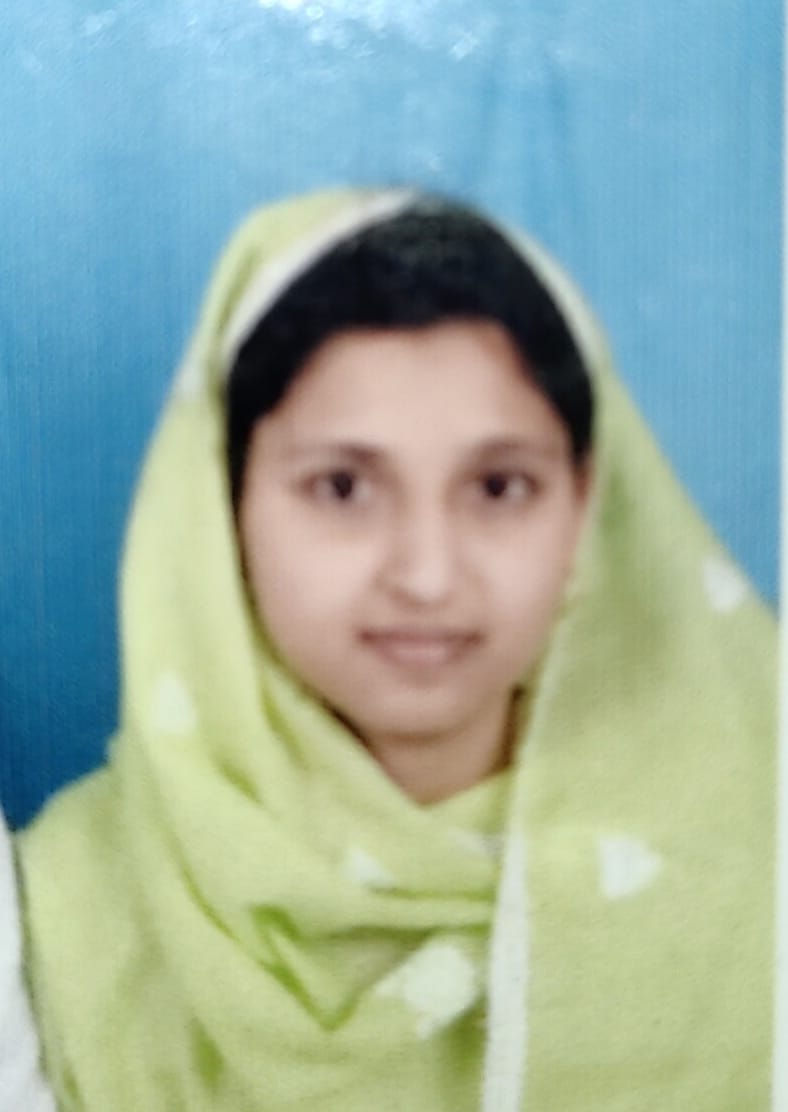 |
| SACT | |
| M.Sc in Mathematics | |

|
Students
Intake
| UR | OBC-A | OBC-B | SC | ST | PH | TOTAL | |
| 35 | 07 | 5 | 15 | 5 | 0 | 67 |
Enrollment
Enrollment 2019-20, 1st semester Honours
| Total | Male | Female | SC | ST | OBC-A | OBC-B | General |
| 45 | 27 | 18 | 08 | 03 | 15 | 04 | 15 |
Enrollment 2019-20, Part II Honours
| Total | Male | Female | SC | ST | OBC-A | OBC-B | General |
| 34 | 22 | 12 | 5 | 01 | 14 | 02 | 12 |
Enrollment 2019-20,Part III Honours
| Total | Male | Female | SC | ST | OBC-A | OBC-B | General |
| 25 | 17 | 8 | 04 | 00 | 09 | 04 | 08 |
Mathematics General Course
| Part-I | Part-II | Part-III | TOTAL |
| 18 | 14 | 9 | 41 |
Teaching Methods
-
-
- Project work/ Lab based learning/ Dissertation etc :
-
The students have lab course in their curriculum, for that the department organizes regular class in Computer lab for their numerical analysis and basic C programming language. The students also given in hand basic training to the basic functions of a computer
-
-
- Internal assessment:
-
The department organizes regular internal assessment as per with the current CBCS syllabus and also various problem solving classes taken for their quality enhancement.
-
-
- Group Discussion :
-
Regular Group Discussion also organized for enhancement of their ability for leadership quality, speaking ability, public speaking ability, social skills.
-
-
- Quiz :
-
For enhancement of their competitive mind and increasing problem solving skills the department organizes quiz competition regularly.
-
-
- Participatory Learning :
-
Along with the traditional chalk and board method the department has also ICT based classroom.The students are encouraged to ask doubt in classroom and also hard problems in mathematics given to sharpen their minds.
-
-
- Strategies for slow learners :
-
Special and extra classes and examination are taken for the slow learner.
The department has a department library and students also uses the central library facility
The college has a student friendly interactive portal where teachers upload study materials, Students can ask queries which can be accessed by the teachers. Moreover Live classes via Google Meet are also taken.
Study materials also regularly uploaded in the college websites by the faculties of this department.
N-LIST is extensively used by the faculty and the students of the department.
Guidance to the students to access e-resources are also provided.
Name of the event- Online state level webinar on “Preliminary Concept of Cosmology and Modern Algebra”
Date- 24th June, 2021
Resource Person-
1. Professor Subenoy Chakraborty
Department of Mathematics
Jadavpur University, India
2. Professor Sukhendu Kar
Department of Mathematics
Jadavpur University, India
No of participants-75
Seminar outcome
In this online lecture, Prof. Subenoy Chakraborty has explained the concept of Early history of the Universe. He starts from bing bang singularity and then he explain the accelerate expansion of the Universe. In Relativity explains how space and time are linked for objects, that are moving at a consistent speed in a straight line. Prof. Chakraborty beautifully explained the facts and mathematical background of STR. Otherside Prof Sukhendu Kar gave the basic concept of modern algebra mainly Group theory very interestingly and in the interactive session students was very much interest to learn more about this topic.
Session: 2020-21
National Webinar on “Some Important Topics on Geometry, Cryptography and Discrete Mathematics”
- Date: 22 July, 2020.
- Resource Persons:
Dr. Ranjit Mehatari, Department of mathematics NIT, Rourkela
Prof Avishek Adhikari, Department of Mathematics Presidency University
- Number of Participants: 50
- Outcome:
In the age of digital world it is very important to secure our digital financial transactions, personal data and our internet connectivity. To keep above thing in mind the Department of Mathematics organized a webinar on Cryptography and Graph Theory. The audience got to know about basics of RSA system and basics of Graph Theory. Students learn about security system and got motivation to pursue Cryptographer as a carrier option.
Name of the event- Online special lecture on” Relativity: A Layman’s Perspective”
Date- 24th June, 2020
Resource Person-
Professor Subenoy Chakraborty
Department of Mathematics
Jadavpur University, India
No of participants-105
Seminar outcome
In this online lecture, Prof. Subenoy Chakraborty has explained the concept of Einstein’s Special Theory of Relativity in simple and ‘layman’s’ language. Einstein’s Special Theory of Relativity explains how space and time are linked for objects, that are moving at a consistent speed in a straight line. The theory is famous for predicting some really weird phenomena like how Earth and solid objects change their shapes at high speeds. Professor Subenoy Chakraborty beautifully explained the facts and mathematical background of STR. His simple yet informative presentation was highly appreciated by participant teachers, students and other science enthusiasts.
Session: 2018-2019
Special Lecture on ‘The Fixed Point Theory and Metric Spaces’
- Date: 10 April, 2018.
- Resource Person: Prof. Kali Shankar Tiwary Departmrnt of Mathematics, Raiganj University
- Number of Participants: 80
- Outcome of the Special Lecture:
It was a great pleasure that professor like Kali Shankar Tiwary had given a talk to the students and faculty members. His specialization was in Functional Analysis. The talk was on fixed point theory. He started from basics of Real Analysis and Metric Spaces. Students got motivation and enthusiasm from that talk.
Telephone No.: +91-9614174663
Email: drmscmath@gmail.com
WhatsApp Group Link
Semester-1: CLICK HERE
Semester-2: : CLICK HERE
Part-2: CLICK HERE
Facebook Page: CLICK HERE


